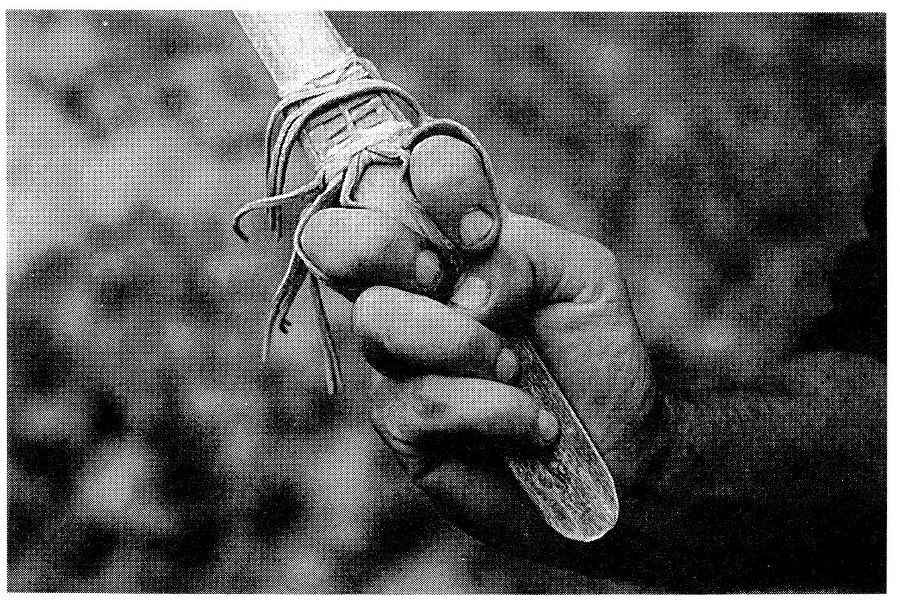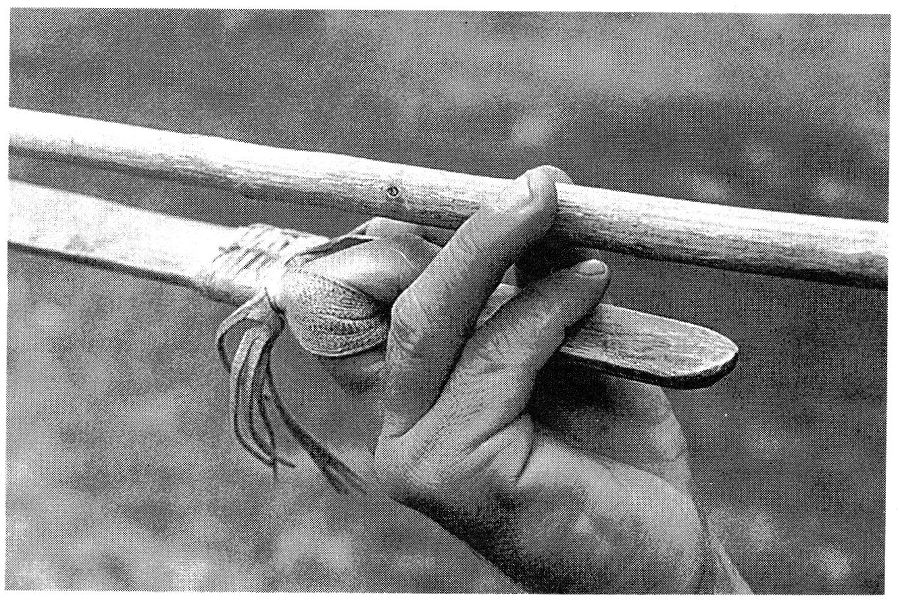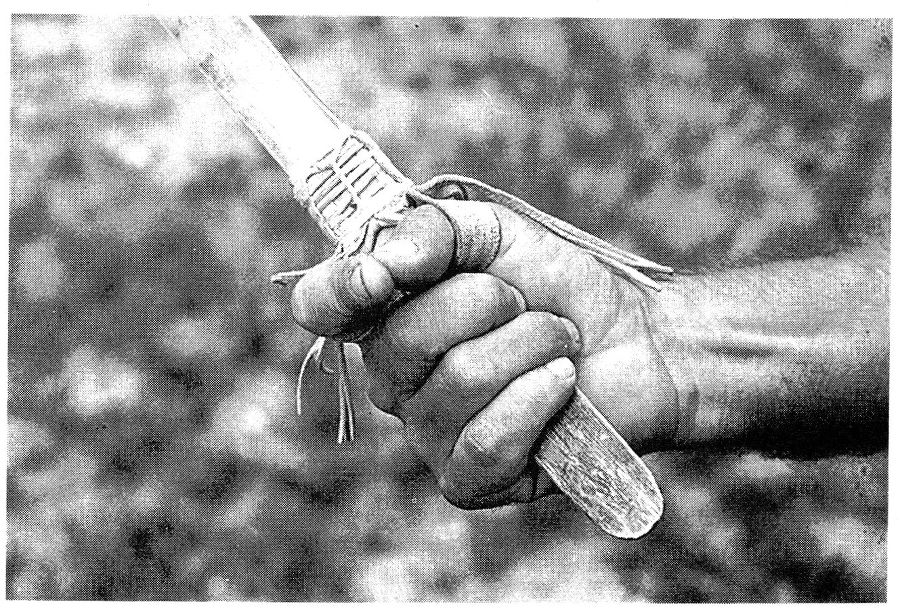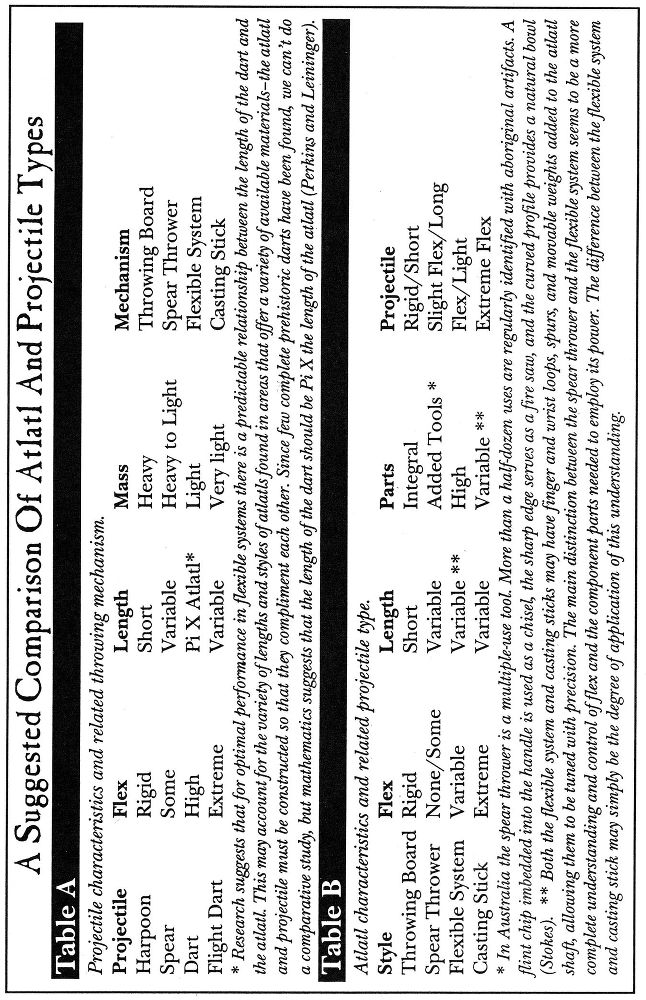Ivory throwers from the times of the Neanderthal to the modern woomeras of contemporary Australian Aborigines fall into this class of atlatl. The spears were a solid shaft with either a fire-hardened tip, hafted point or detachable foreshaft. The detachable foreshaft allowed the hunter to retrieve the spear and reload with a new foreshaft, ready to fire again. Thus the weight of additional spear shafts was exchanged for numerous foreshafts-not to mention the extra labor needed to produce a full-length spear.
Flexible System
The addition of component parts, bannerstones, counterweights and a notable preference for very light, springy darts with detachable foreshafts gave this system the ability to be engineered specifically to the needs of the hunter.
The stored energy of the flexible atlatl and dart propeled the light projectile with amazing speed, force and distance. The adaptability of the system allowed it to be used under a broad range of conditions and constructed from numerous serviceable materials. Most evidence of this system has been found in the arid caves of the southwest United States.
Oak atlatls of less than a quarter inch thick and fragile darts made from the papery canary reedgrass were common. Weighted systems from the Great Basin display broad varieties of size and design that may suggest that quivers of atlatls and darts may have been carried to compensate for varying size and distance of game. The main distinction between this system and the spear thrower is that an obvious mental shift took place to harness and maximize the use of flex and stored energy.
Casting Stick
Was the “Baton de Commandment” a shaft straightener, badge of office or casting stick? It has been suggested that a thong attached to the baton made it a perfect handle for casting arrows over incredible distances (Comstock/Baker/Ratzat). An interest in this activity was nurtured at the turn of the century, but has enjoyed a new resurgence with efforts to establish modern flight records for hand-thrown darts and arrows.
The thong-thrown arrow employs the simple idea of a very flexible atlatl shaft. Today we see a variety of systems that employ sophisticated understanding of flex and counterweights. With distance being the goal, very light sets can be built that reduce air drag and maximize the benefits of flex and recoil in both the atlatl and dart (Brian). Distances of over 300 yards suggest an apparatus that was used to throw a projectile from a high-arcing flight into a crowd or a herd, literally taking pot-luck.
Atlatl Basics
The basic principle behind the use of the atlatl is that when you increase the arc of the throwing pattern, you also increase the length of time that force is applied to the projectile (the velocity of a point on a radius is higher the further it is from the axis point). In other words, if a major league pitcher can hurl a fast ball at 100 miles per hour, just think what you would have if you could fit a gorilla, with 20% longer arms, into that same uniform (although you may have trouble getting it to wear that little cap).
With this mechanical advantage, a 6- to 10-foot spear can be thrown over 100 yards, as opposed to only about 100 feet with the unaided arm. When used to propel a heavy harpoon with a rigid throwing board, the harpoon will travel farther and at a much faster rate than if thrown by hand.
For increased potential, add to this principle the idea that if both the dart and/or atlatl are made of flexible materials and allowed to act as springs, their flex and associated recoil actually make the dart a self-projecting missile that snaps off of the atlatl at a greater velocity than can ever be generated by hand (Perkins and Leininger).
A large spear with some flex, thrown by a long atlatl with some flex, will be propelled farther, faster and with more energy than by hand. If this idea is magnified and controlled by an increase in flex, and the addition of counterweights that time the flex and de-flex of the system’s components, all of the above factors, as well as accuracy, are enhanced.
If long-distance goals are your target, refine these same principles even farther, and you have projectiles that can be thrown well over 300 yards. The speed and force with which the projectiles travel will also be markedly improved.
When using an atlatl system, there are typically two methods for gripping the atlatl: split finger and power grip, and two distinct styles of throwing: accuracy and long distance.
Split finger grip—The index and middle fingers are placed into the finger loops or holes from the back of the atlatl, with the spur extending away from the body. The third and little fingers wrap over the handle of the atlatl and are gripped by the thumb coming from the other side. The dart is held in place against the spur between the tips of the thumb and third finger, and lies along the shaft of the atlatl between the index and middle fingers. Some increase in short-distance accuracy may be achieved by this grip, but it may feel awkward.
Power grip—The thumb and index finger are placed into the finger loops or holes from the back of the atlatl, with the spur extending away from the body. The remaining fingers grip the handle. The dart is held in place against the spur between the tips of the thumb and middle finger, and lies along the shaft of the atlatl on top of the grip fingers. This is a more natural-feeling grip, and may provide some increase in distance.

Split-finger grip. (Photo: Wescott)
Throwing for accuracy—The motion is somewhat like a cross between pitching a baseball and throwing darts at a dart board-you try to employ a somewhat flat delivery while maintaining control and speed.
The atlatl is held flat at shoulder height.
As the throw begins, you draw the dart back for a wind-up and step forward.
As you begin to propel the dart forward, the body begins to lower slightly, allowing you to begin the power arc with the handle, yet maintain a flatter trajectory with the spur end. The dart is released toward the point of aim at this point.
Follow through as if you were pitching a fast ball.
The final portion of the throw is a slight wrist snap and follow-through.
Throwing for distance—This motion is identical to throwing a rock or baseball. You can wind up by running and then throwing as you would a javelin.
The atlatl is held flat at shoulder height.
As you begin to propel the dart forward, the shoulder and elbow rotate forward to increase power. The dart is released at a trajectory of about 41° at this point.
The entire upper body rotates forward to increase the force applied.
The arm and wrist follow through and the dart snaps out of the spur.

Split-finger grip. The dart is held in place against the spur between the tips of the thumb and third finger and lies along the shaft of the atlatl between the index and middle fingers. (Photo: Wescott)

Power Grip. (Photo: Wescott)

Making Darts
Most people spend far too much time on the aesthetics of their atlatl rather than on the mechanics of the system. But the dart is the most important component of the system (Perkins), and has to be custom-made to the thrower (Frison).